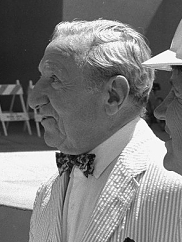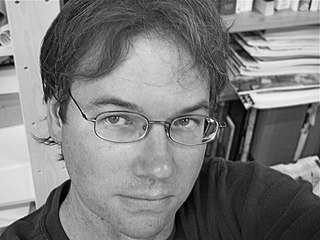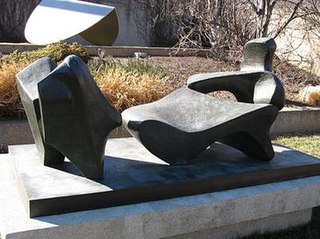
Kryptos is a sculpture by the American artist Jim Sanborn located on the grounds of the Central Intelligence Agency (CIA) headquarters, the George Bush Center for Intelligence in Langley, Virginia. Since its dedication on November 3, 1990, there has been much speculation about the meaning of the four encrypted messages it bears. Of these four messages, the first three have been solved, while the fourth message remains one of the most famous unsolved codes in the world. The sculpture continues to be of interest to cryptanalysts, both amateur and professional, who are attempting to decipher the fourth passage. The artist has so far given four clues to this passage.
Herbert James Sanborn, Jr. is an American sculptor. He is best known for creating the encrypted Kryptos sculpture at CIA headquarters in Langley, Virginia.

The Hirshhorn Museum and Sculpture Garden is an art museum beside the National Mall in Washington, D.C., United States. The museum was initially endowed during the 1960s with the permanent art collection of Joseph H. Hirshhorn. It was designed by architect Gordon Bunshaft and is part of the Smithsonian Institution. It was conceived as the United States' museum of contemporary and modern art and currently focuses its collection-building and exhibition-planning mainly on the post–World War II period, with particular emphasis on art made during the last 50 years.

Robert Gober is an American sculptor. His work is often related to domestic and familiar objects such as sinks, doors, and legs.

Joseph Herman Hirshhorn was an entrepreneur, financier, and art collector.
The Cyrillic Projector is a sculpture created by American artist Jim Sanborn in the early 1990s, and purchased by the University of North Carolina at Charlotte in 1997. It is currently installed between the campus's Friday and Fretwell Buildings.

Greg Colson is an American artist best known for his works that straddle the line between painting and sculpture, which address concepts of efficiency and order. Using scavenged materials, Colson allows the physicality of his makeshift constructions to intrude on the precise systems he paints or draws upon their surfaces - striking a balance between subject and context, image and support, order and chaos.

Throwback is a public artwork by American artist Tony Smith, located at the Hirshhorn Museum and Sculpture Garden in Washington, D.C., United States. This version is the third of an edition of three in the series with one artist's proof.

Needle Tower is a public artwork by American sculptor Kenneth Snelson located outside of the Hirshhorn Museum and Sculpture Garden in Washington, D.C., United States.

Last Conversation Piece is a public artwork by Spanish sculptor Juan Muñoz in the collection of the Hirshhorn Museum and Sculpture Garden in Washington, DC, United States. The piece is currently on loan to The Contemporary Austin.

Are Years What? is a sculpture by American artist Mark di Suvero. It is in the collection of the Hirshhorn Museum and Sculpture Garden, in Washington, D.C., United States. The sculpture is named after poet Marianne Moore's "What Are Years". From May 22, 2013 through May 26, 2014, the sculpture resided temporarily in San Francisco, as part of the San Francisco Museum of Modern Art's Mark di Suvero exhibition at Crissy Field.

Three-Piece Reclining Figure No. 2: Bridge Prop is a sculpture by Henry Moore, created in 1963, and produced in an edition of six copies.

Lunar Bird is an abstract bronze sculpture by Joan Miró. It was modeled in 1945, enlarged in 1966, and cast in 1967.

Elonka Dunin is an American video game developer and cryptologist. Dunin worked at Simutronics Corp. in St. Louis, Missouri from 1990–2014, and in 2015 was Senior Producer at Black Gate Games in Nashville, Tennessee. She is Chairperson Emerita and one of the founders of the International Game Developers Association's Online Games group, has contributed or been editor in chief on multiple IGDA State of the Industry white papers, and was one of the Directors of the Global Game Jam from 2011–2014. As of 2020 she works as a management consultant at Accenture.
Evan Holloway is an American artist. Holloway received his BFA in 1989 and his MFA in 1997 from the University of California. He lives and works in Los Angeles, USA. Holloway is currently represented by Xavier Hufkens in Brussels and David Kordansky.

Linn Meyers is an American, Washington, D.C.–based artist. Her work has been exhibited in the United States and abroad. She is known for her hand-drawn lines and tracings for site-specific installations.
Olga Hirshhorn was an American collector of 19th and 20th century art and supporter of art museums.
Sue Williams is an American artist born in 1954. She came to prominence in the early 1980s, with works that echoed and argued with the dominant postmodern feminist aesthetic of the time. In the years since, her focus has never waned yet her aesthetic interests have moved toward abstraction along with her subject matter and memories. She lives and works in New York.















